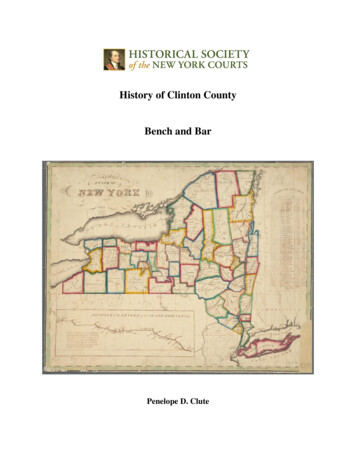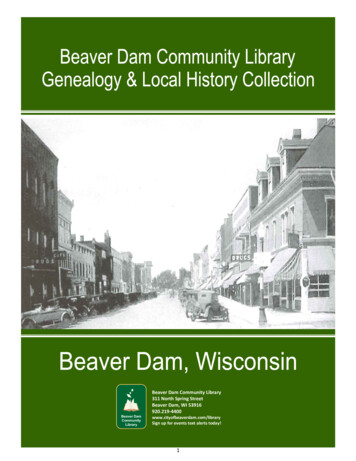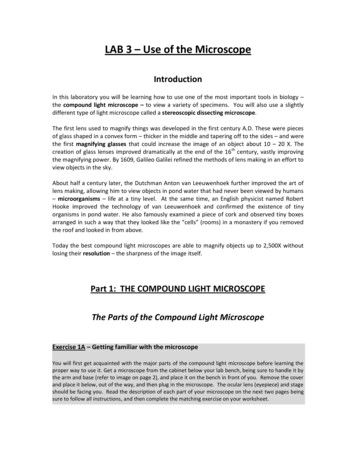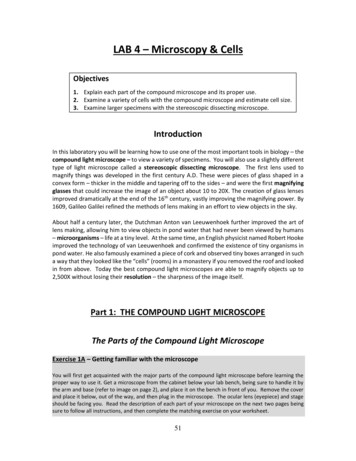
Transcription
History of Clinton CountyBench and BarPenelope D. Clute
The Historical Society of the New York CourtsCounty Legal HistoryClinton CountyPenelope D. CluteCounty Introductory Essay (Origins & History)Clinton County is in the northeast corner of New York State, 300 miles directly north ofNew York City, and the eastern edge is bounded by Lake Champlain. The first European to explore the waters of Lake Champlain was Samuel de Champlain, who came in July of 1609, starting from the Richelieu River in Canada and traveling south. There were 24 canoes, with twoother white men and 60 Algonquins and Hurons on their way to attack the Mohawks. Therewere no white settlements at that time.New York State was divided into twelve counties in 1683, with the present ClintonCounty as part of Albany County. This was an enormous county, including the northern part ofNew York State as well as all of the present state of Vermont and, in theory, extending westwardto the Pacific Ocean. This county was reduced in size on July 3, 1766, by the creation of Cumberland County and further on March 16, 1770, by the creation of Gloucester County, both containing territory which is now in Vermont.On March 12, 1772, what was left of Albany County was split into three parts, one remaining under the name Albany County, with Charlotte County containing the eastern portion.In 1784, the name "Charlotte County" was changed to Washington County to honor GeorgeWashington. In 1788, Clinton County was split off from Washington County. It was a muchlarger area than the present Clinton County, including several other counties or county parts.112-02–2014
Timeline1763: The first European settlers in the area were Jean Baptiste LaFramboise, his brother Bonhomme, and Frank Monty, who came in 1763 to what became known as Chazy, on the shore ofLake Champlain 12 miles north of Plattsburgh. The British drove them out in 1777, but they returned in 1783.1766: South of Plattsburgh, at the mouth of the Salmon River, then known as Mill Creek, William Gilliland settled on the Friswell Patent in 1766, building what became known as PossessionHouse. Gilliland was a New York City merchant who settled Willsborough with others about ayear earlier.1767: The first white settler in Plattsburgh was Count Charles de Fredenburgh, a German nobleman who was a captain in the British army. He established a residence and sawmill on the Saranac River in 1767, then petitioned for and received 30,000 acres from the King of England. Ashort time before the Revolution, he moved his family to Montreal. He returned to protect hisproperty, but his house and mill were destroyed by fire and he disappeared, rumored to havebeen murdered.1785: Plattsburgh was first continuously settled in 1785, when Zephaniah Platt, MelanctonSmith, Ezra l’Hommedieu and Thomas Treadwell led a group up Lake Champlain and established a settlement at the mouth of the Saranac River. Peter Sailly, recently immigrated fromLorraine, France joined them as one of the original proprietors of the new town and village ofPlattsburgh.1788: When Clinton County was formed in 1788, the population of the village of Plattsburghwas only 200; it became the county seat. There were no lawyers in Clinton County, so positionsin the newly-created courts were filled by the leading businessmen. The first judicial officers inthe county were Charles Platt as the First Judge of the Court of Common Pleas and AssociateJudges Theodorus Platt, Pliny Moore, Peter Sailly, William McAuley and Robert Cochrane.Theodorus Platt was also the Surrogate. Pliny Moore was the founder of the Town of Champlain, and appointed the first justice of the peace there.212-02–2014
1788: The first Court of Sessions for the county of Clinton was held in October, 1788. According to the History of Plattsburgh from Its First Settlement to January 1, 1876 by Peter S. Palmer,at p. 26,Judge Charles Platt presided, assisted by [the five AssociateJudges;] Benjamin Mooers was Sheriff, and Melancton L. Woolsey, Clerk. The coroner, four constables and seventeen grand jurorswere in attendance. Of the latter sixteen were sworn in and onewas set aside ‘for refusing to take the oath of allegiance.’ Thisjury, the first grand inquest which assembled in Northern NewYork, closed its labors by indicting two of its members for officialmisconduct.They were tried at the next term of the court, when one wasacquitted and the other convicted and fined. The courts were verystrict to enforce prompt attendance on the part of jurors and officers. The records are filled with orders imposing fines upon dilatoryconstables and grand and petit jurymen. The Bench was not alwaysoverlooked. In 1825, two of the Associate Judges were indictedfor ‘not attending at court the first day,’ and two others, in 1827,for the same offense.”1795: According to the History of Clinton and Franklin Counties, the first resident lawyer inClinton County was Adrial Peabody, admitted to the bar in 1795. He was followed by CalebNichols in 1796, Eleazer Miller in1797, Silas Hubbell and Jonathan Griffin in 1802, John Warford in 1805. Julius C. Hubbell, who studied law in the office of his brother Silas, was admittedin 1808, brothers Gilead and Anson Sperry also in 1808, John Palmer and Reuben H. Walworth,both moved to Plattsburgh in 1810 after being admitted to the New York bar that year, and William Swetland in 1811.312-02–2014
County CourthousesName of Courthouse: BlockhouseOn the Point, near shores of Lake Champlain, at mouth of Saranac River, Village of PlattsburghDate Built:1789The blockhouse was originally built for a jail. It was subsequently enlarged to also use asa courthouse, school house and place of public worship. In 1795, 40 was voted for completionof the separate courthouse, and court began being held there in 1796 even though the buildingwas unfinished. The first Circuit Court of Oyer and Terminer for the northern part of the statewas presided over by Judge Lansing in Plattsburgh in August 1797; then at the blockhouse inWillsborough in 1798. 100 was authorized to complete the Plattsburgh court in 1799, and apermanent wooden jail and courthouse building was finished in 1803 for total cost of -------------------------------1803 CourthouseCorner of Court and Margaret Streets, PlattsburghDate Built:Completed in 1803Architect:Pliny MooreMaster Builder:Jabez FitchArt & Architecture: Wooden structure, housing the jail and courthouseAn English merchant, Samuel Bridge, kept a diary during his 1809 visit to Canada andthe United States. He travelled through Plattsburgh on October 19, making a stop at the courthouse, which is described as “a very neat building.” He continued, that the “court-room is madeuse of as a place of worship. We were introduced into the jail and black hole -- two very snug,little, comfortable, dark apartments. No prisoners at present.”During the Battle of Plattsburgh in 1814, the British took possession of Plattsburgh andimmediately “broke open the jail and let out two persons confined for murder.” During the battle, the courthouse and several other buildings burned. In May 1815, the town supervisors authorized building a “gaol and courthouse for the County of Clinton” of brick and stone “to be thesame size as the former 014
1816 CourthouseCorner of Court and Margaret Streets, PlattsburghArt & Architecture: Brick and stoneThe Plattsburgh Republican of March 16, 1889 quotes the October 4, 1816 minutes ofthe County Supervisors authorizing Reuben Walworth “to go to the City of Washington to receive 8000 for the destruction of the county court house.” The article noted that this was because the courthouse was destroyed by order of American General Macomb during the siege andbattle at Plattsburgh.In his eye-witness account, Sergeant Robert Keith of the U.S. Infantry reports that theBritish occupied some buildings close to the banks of the Saranac River. He wrote that GeneralMacomb ordered those buildings burned. “Many red-hot shot were fired into the buildings. Thecourt-house, Jail, and several houses were set on fire and destroyed. These buildings, standingon the hillside, would have afforded the enemy a cover for the erection of forts and planting batteries. Their idea was to mask their operations, then destroying their barriers, open on us withtheir heavy guns. But after the buildings were destroyed, we could sweep the field with our 24lb. shot” quoted in Lake Champlain Weekly, August 27-September 2, 2014, at page 5.On October 1, 1816, the Court of Common Pleas occupied the new courthouse. Thatcourthouse was destroyed by fire on May 17, 1836, after fire caught in a stable or shed in the jailyard, close to the cornice of the courthouse. The newspaper reported that “little could be done tosave the building,” which was completely gutted, although the walls remained standing. Theprisoners were unharmed and moved to the Essex County Jail. Eleven days later, the New YorkState Senate passed a bill authorizing funds to rebuild the -------------------------------------1836 CourthouseCorner of Court and Margaret Streets, PlattsburghDate Built:Completed in 1836On June 10, 1836 the court clerk issued a notice that the basement of the nearby TrinityChurch would be the temporary courthouse because of the fire. It appears that the new courthouse was completed by the end of 1836. This courthouse was in serious disrepair before its usewas discontinued. The minutes of the Board of Supervisors November 15, 1887 Annual Sessioninclude a resolution to build a new courthouse and jail based on a report set forth in the minutes,512-02–2014
which concludes that “the buildings are in very bad condition, and wholly insufficient for theneeds of the county. The Court House is old, the woodwork decayed, and the foundation andwalls in no such substantial condition as would warrant building upon, or any outlay in repairs.”According to the report, among other issues, thetotal lack of room for the Judges of the Court, or for consultationrooms, usually provided, and necessary for the decent transactionof business; the inadequate size and arrangement of the court roomitself; and the lack of proper rooms for the Grand Jury and roomfor the Petit Jury have long been cause of complaint It is notorious that the Court House of this county is regarded by citizens, athome and abroad, by Jurors and Judges, Attorneys and witnesseswho are compelled to meet there, as a public nuisance As to the Jail, the place is unfit for the confinement of human beings of any grade or color. It would be counted a disgraceto any barbarous community to shut up in such a place any humanbeing, whatever his crime. It cannot be repaired or improved; itshould be torn down.1836 Courthouse - Photograph courtesy of the Clinton County Historical -------------------------------------612-02–2014
The “Old” CourthouseCorner of Court and Margaret Streets, PlattsburghDate Built:Completed in 1889Architect:M.F. Cummings, TroyBuilder:Brown Bros.Art & Architecture: Late Victorian “Richardson Romanesque” styleFinally, in 1889, a new courthouse was erected at the same location, also made frombrick and stone. The “first story was broken ashlar face, irregularly laid The next story ismoulded red Glens Falls pressed brick” and the window sills and steps are cut local limestone.There is an 85-foot brick tower over the entrance. After the building’s completion in 1889, theBoard of Supervisors directed the Sheriff to “put in the belfry of the new courthouse the bell formerly used in the old courthouse.” The bell is stamped “from A. Meneely, West Troy NY1851.” Reportedly, there was an eagle carved by an inmate at Dannemora prison placed over thedoor during a celebration at the end of World War I. The eagle presently over the door wascarved in recent years. That Late Victorian Romanesque building, now referred to as the OldCourthouse, still stands at the corner of Margaret and Court Streets.1889 CourthouseNext to it is the old Surrogate Building; both buildings are on the National Register ofHistoric Places, and both presently house county-related agencies. The Surrogate Building was712-02–2014
built in 1884 and is the oldest government building in the area. The first floor housed the Surrogate and the County Clerk, where there is a fireproof safe, and the second floor was for the Boardof Supervisors. The architect and builder was T.T. Ferguson. It is "early Victorian Italianate"style, also called "Italian Palazzo" style, made from local limestone and Pennsylvania pressediron brick, with pre-cast lintels, hood and ------------------------------------Clinton County Government CenterCorner of Cornelia and Margaret Streets, PlattsburghDate Built:Completed in 1976The current courtrooms are on the third floor of the Clinton County Government Center,completed in 1976.Clinton County Government Center from Margaret StreetThe wall behind the Court Receptionist’s desk is a mural of notable buildings in the Plattsburgharea.812-02–2014
Mural on Third Floor of Government CenterThe BenchGeorge M. Beckwith, 1805 1883, first studied medicine like his father, then changed to law in1828, reading law in Plattsburgh with attorney St. John B.L. Skinner. He was admitted to the barin 1832 and formed a partnership with William Swetland until 1847. He eventually practicedwith his sons, George H. and Benjamin M. Beckwith.Positions:1841NYS Assembly1864-71US Commissioner1872-74Clinton County --------------------------------Norman L. Harvey, 1918 96, was born in Canisteo, Steuben County. He graduated from Syracuse University College of Law and was admitted to practice in 1948. His education wasinterrupted by World War II where he served as a pilot and air executive officer in theArmy Air Corps, completing 74 combat missions over Germany and Axis-occupiedEurope. In 1949, Justice Harvey was elected Mayor of Canisteo. His career was912-02–2014
interrupted by a second tour of military duty in the Air Force during the Korean Warwhen he became Commanding Officer of the 509th air refueling squadron and the 715thbomb squadron. He was later transferred to the Office of the Secretary of the Air Forcein Washington, D.C., and was discharged with the rank of Colonel. Following hismilitary service, Harvey and his family moved to Plattsburgh, where he becameassociated with the law firm of Jerry, Lewis & Harvey. He was elected to the SupremeCourt, Fourth Judicial District, in 1967, and was appointed district Administrative Judgein 1975. Effective January 1, 1984, he was designated to the Appellate Division. Heserved on the Court until his retirement in --------------------------------Henry Theodore Kellogg, 1869 1942, was the first Clinton County lawyer to rise to the NewYork Court of Appeals, where he served from 1927 to 1934, when he resigned due to ill health.The following is excerpted from the biography of Judge Kellogg found on this website underCourt of Appeals Judges:Henry Theodore Kellogg was a distinguished son of Northern New York who continueda family legacy on the bench. Born in Champlain in Clinton County, New York on August 29,1869, he was the son of Sylvester Alonzo Kellogg, a Plattsburgh lawyer, and Susan Elizabeth(Averill) Kellogg. The Kellogg family was a prominent one in Northern New York and was saidto be descended from Chancellor Kent. Henry Kellogg's father had been justice of the state Supreme Court and also served on the Third Department of the Appellate Division at the designation of Governor Theodore Roosevelt. Henry Kellogg's great-great-grandfather died of exposureand disease as result of participating in Benedict Arnold's expedition against Québec in 1775.The Kelloggs descended from Lieutenant Joseph Kellogg, who before 1651 came to Connecticutfrom England.He received an LL.B. from Harvard Law School in 1892 and returned home to Plattsburgh where he entered into a law practice in his father's law office, the firm of Kellogg, Weedand Palmer. He then became a law partner of Judge L.L. Shedden and was also associated withCharles E. Johnson. He practiced until elected county judge in Clinton County in 1903. From1012-02–2014
1898 to 1903, Kellogg also served as a referee in bankruptcy. On March 5, 1903, Judge Kelloggmarried Plattsburgh resident Katherine Miller Standish Weed, the daughter of Smith MeadWeed, his law partner.Kellogg resigned from county court after less than six months of service when, on June25, 1903, Governor Benjamin B. Odell, Jr. appointed him justice of the Supreme Court, FourthDistrict. Kellogg's father, S. Alonzo Kellogg, previously held the Supreme Court seat, and theNew York Times reported that the father resigned from the post early - his term did not expireuntil December 31, 1904 - in the hope that his son would be his successor. The younger Kelloggwas elected to Supreme Court in November 1903 and then reelected in 1917 for a second termending in 1931. He served on the trial bench until his appointment to the Third Department of theAppellate Division on January 1, 1918. Kellogg has been credited with making the Workmen'sCompensation Law workable through his jurisprudence on the subject while a justice of the Appellate Division.Kellogg served on the Appellate Division until he became a judge of the Court of Appeals, elected in November 1926 to fill the vacancy created by the retirement of Judge Chester B.McLaughlin (1856-1929), and his term began on January 1, 1927. Although Kellogg was a Republican, he had received bipartisan endorsement. He had been considered for the Court of Appeals in 1923, but withdrew at that time and Judge Irving Lehman (1876-1945) filled the seat.Although his term did not expire until December 31, 1939, Kellogg resigned from the Court ofAppeals on May 16, 1934 due to failing health.Important Decisions:Among Judge Kellogg's best-known writings as a Court of Appeals judge was Sliosbergv. New York Life Insurance Company, 244 N.Y. 482 (1927). That case involved the constitutionality of a provision in the Civil Practice Act that stayed proceedings on certain insurance policiesissued in Russia until after the United States formally recognized the new Soviet government.Former Governor Charles E. Hughes and John Foster Dulles represented the carrier. Like theAppellate Division below, the Court of Appeals held that this indefinite stay violated the federalconstitution's prohibition on the impairment of 4
S. Alonzo Kellogg, 1838 1904, [father of Henry] who was born in Champlain, Clinton County,was the first Clinton County attorney to sit on the Appellate Division, Third Department, the intermediate appellate court which encompasses Clinton and 27 other counties. He was educatedat the Champlain Academy and graduated from Middlebury College in 1860. He first practicedlaw in Nevada (then called Utah Territory) and during his residence there (near Virginia City) hewas elected in 1864 as a senator in that state's first legislature. When he returned east in 1866, heopened a law office in Plattsburgh. He was elected Clinton County District Attorney for oneterm, beginning 1876. From 1881 to 1890, he was Clinton County Judge. In 1890, he waselected to the Supreme Court for the Fourth Judicial District in the Third Department. He alsoserved in 1890 as a member of the Constitutional commission appointed by Governor Hill to revise the Judiciary Act. The commission's report was influential at the 1894 Constitutional Convention, which adopted reforms creating the Appellate Division.Justice Kellogg was appointed to the Appellate Division in 1899, and retired from the Courtin 1903 because of ill health. He died on March 12,1904. His son, Henry T. Kellogg, succeededhim on the Supreme Court and eventually was named to the Appellate Division and then theCourt of Appeals. The Kellogg family lineage includes Elijah Kellogg of Revolutionary War (Ticonderoga) fame and is connected to the great New York State Chancellor, James Kent and Secretary of State Frank B. Kellogg (during the Coolidge Administration). Justice Kellogg's wifewas a direct descendant of Zephaniah Platt, founder of Plattsburgh. The second Clinton Countyattorney to sit on the Appellate Division was his son, Henry T. Kellogg, who sat there from 1918through 1926, before his appointment to the Court of ----------------------------------John A. Lahtinen was appointed to the Appellate Division, Third Department effective March6, 2000. He is a graduate of Colgate University and Albany Law School. After hisadmission to practice in 1971, he engaged in the private practice of law in Plattsburgh,Clinton County, until he was appointed and then elected Justice of the Supreme Court for theFourth Judicial District in 1997. Justice Lahtinen also served as law secretary to the late JusticeNorman L. Harvey in the early 1970s as a Clinton County special acting District Attorney and asa Plattsburgh special acting City Court --------------------------------1212-02–2014
Luella R. North, 1872 1962, was the first female judge in Clinton County. She sat as the Children’s Court Judge of Clinton County from 1923-1935, which was the entire existence of thatcourt. She was not an attorney, but had been a teacher before her marriage in 1900. A local Republican leader asked her in the summer of 1922 to run for the new Children’s Court. Sheagreed to do so and, according to her daughter, “our [summer] vacation began to be interruptedby visits from prominent leaders throughout the State. Some were wealthy woman [sic] of socialprominence who had become active in the Woman’s Suffrage Movement.” She was one of onlythree women in the state running for that office. She won the election, and re-election six yearslater. Thereafter, Children’s Court was consolidated with County Court. The information here isfrom the memories of her daughter, also Luella, published in 1991. Luella said of herself thatshe “secured a Master’s Degree in Social Work, an interest certainly inspired . . . by my association with her and her court work.”Her husband, Dr. Charles Henry North, became Superintendent of Dannemora State Hospital for Insane Criminals in 1904. In 1917 he was murdered by an inmate of the facility, a“trusty” well-liked by the North family, who had a home on the hospital grounds. Her son,Thomas R. North was Plattsburgh City Court Judge 1948-1950, then District Attorney of ClintonCounty from 1951 to 1972. Her other son Grover was also an -----------------------------------George W. Palmer, 1818 1916, studied law in the offices of John Palmer, then Swetland &Beckwith, then Daniel Gardner in Troy, and was admitted to the bar in 1843.Positions:1844-47Surrogate of Clinton County1857-61US House of Representatives - the first Republican from this district1862Consul to Crete - appointed by President Lincoln1866-70Judge of the Mixed Court of Sierra Leone - created by an internationaltreaty to suppress the African slave trade1885-86NYS -----------------------------------1312-02–2014
John Palmer, 1785 1840, was born in Hoosick, New York, moved to Plattsburgh after beingadmitted to the bar, and was law partners with Reuben H. Walworth from 1811-20. Among theircases were collections on behalf of businessmen Bailey and Delord, who had extended credit tosoldiers posted in the Plattsburgh area during the War of 1812. In 1811, Palmer married Charlotte, the youngest daughter of Peter Sailly.Positions:1817-19US House of Representatives1819-32District Attorney of Clinton County1832-37“First” Judge of Clinton County1837-39US House of ------------------------------------------Peter Sailly Palmer, 1814 1890, son of John Palmer and grandson of Peter Sailly, studied lawin the office of William P. Haile in Plattsburgh, then the firm of McKown and John Van Buren inAlbany. He was admitted to the bar in 1836, then moved to Michigan, where he was elected Macomb County Probate Judge in 1840. However, he resigned in 1841 and returned to Plattsburgh,where he resumed practicing law. He was very interested in the history of this region and published at least three books: Palmer’s History of Lake Champlain, from 1609 to 1814, Battle ofValcour, and Historical Sketches of Northern New York.Positions:1840-41Macomb County, Michigan, Probate Judge1864-68Clinton County Judge and -----------------------------------Zephaniah Platt, 1735 1807, was born on Long Island and educated in England. He studiedlaw, was admitted to the bar and practiced law in Poughkeepsie, then continued practicing law inPlattsburgh in 1798.1412-02–2014
Positions:1775-77Member of the Provincial Congress1777-83NY State Senate - Middle District1781-95NY State Court Judge, Dutchess County1785-86Member of the Continental Congress1788Delegate to NY Convention to ratify US Constitution1791-1807Regent of the State UniversityOne of the “projectors” of the Erie -------------------------------Peter Sailly, 1754 1826 was born in Lorraine, France, immigrated to the US and settled inPlattsburgh in 1785, joining the settlement founded by Zephaniah Platt, who came fromDutchess County. This was a fresh start for Sailly, whose business in France was unsuccessful.He first scouted out the area the year before; after landing in New York, he met William Gilliland in Albany and traveled north with him, by wagon to Lake George, then by canoe across thatlake to take a sloop up Lake Champlain.Plattsburgh was founded in wilderness at the mouth of the Saranac River, where therewas great beauty and commercial possibilities in the dense woods and mountains of ore. Therewas very little settlement on either side of Lake Champlain before or during the American Revolution, except a French settlement at Crown Point. Sailly recalled that the Platts came with asmall amount of milling machinery and a “band of pioneers” with “large amounts of energy andambition.”Sailly was one of the original six Plattsburgh village trustees. He first tried tradinggoods, then soon traded goods for furs, including to John Jacob Astor, who frequently came toPlattsburgh to buy furs. Sailly’s mercantile business prospered, bringing in goods and exportingpotash, created from burning the trees as the forest was cleared, as well as spars and timbers foroverseas trade.Before and during the Battle of Plattsburgh, September 11, 1814, Sailly sent his family toHampton in Washington County while he remained here as collector of customs and military1512-02–2014
storekeeper. British soldiers plundered his house and burned his store. He is buried in RiversideCemetery in Plattsburgh.Positions:1788-96Common Pleas Court Associate Judge1802One of the Commissioners to build a courthouse1789-91, 1803-04Overseer of the Poor1797-98Commissioner of Highways and School Commissioner1799-1800Supervisor of Town of Plattsburgh1802-03NY State Assembly1803Appointed by President Thomas Jefferson as Bankruptcy Commissioner1804“First Judge,” Clinton County1805-07US House of Representatives, NY 11th District (Saratoga, Clinton & Essex Counties) during the first session of President Jefferson’s second term1809Agent to supply goods to the troops stationed in Plattsburgh “to enforce the embargo”1809-26Collector of Customs at Plattsburgh for the District of ------------------------------------Lemuel Stetson, 1804-68, studied law under Julius C. Hubbell in Chazy, then established a practice in Keeseville.Positions:1835NYS Assembly1838-42District Attorney of Clinton County1842NYS Assembly1612-02–2014
1843-45US House of Representatives1846Delegate to New York State Constitutional Convention1847-51Judge of Clinton County1862US House of -----------------------------------------Reuben Hyde Walworth, 1788 1867, was born in Bozrah, Connecticut. He began practicinglaw in Plattsburgh in 1810 with John Palmer and served in the War of 1812, including as actingadjutant-general of the American forces during the siege of Plattsburgh. When President JamesMonroe visited Plattsburgh in 1817, Walworth gave the welcoming address on behalf of the village. He served in Congress from 1821-23.He became circuit judge in 1823, and presided over the first circuit court held in ClintonCounty. He held the 1825 murder trials of Peggy Facto in
1795: According to the History of Clinton and Franklin Counties, the first resident lawyer in Clinton County was Adrial Peabody, admitted to the bar in 1795. He was followed by Caleb Nichols in 1796, Eleazer Miller in1797, Silas Hubbell










